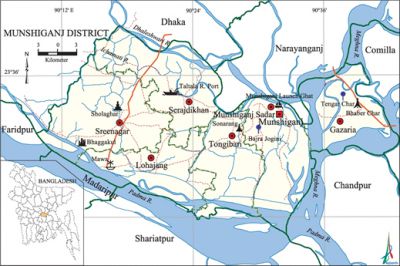Munshiganj District
Munshiganj District (dhaka division) area 954.96 sq km, located in between 23°23' and 23°38' north latitudes and in between 90°10' and 90°43' east longitudes. It is bounded by dhaka and narayanganj districts on the north, madaripur and shariatpur districts on the south, comilla and chandpur districts on the east, Dhaka and faridpur districts on the west.
Population Total 1293972; male 655585, female 638387; Muslim 1181012, Hindu 110804, Buddhist 1922, Christian 103 and others 308.
Water bodies Main rivers: padma, meghna, dhaleshwari, ichamati.
Administration Munshiganj Sub-division was turned into a district in 1984.
| District | |||||||||
| Area (sq km) | Upazila | Municipality | Union | Mouza | Village | Population | Density (per sq km) | Literacy rate (%) | |
| Urban | Rural | ||||||||
|
954.96 |
6 |
2 |
67 |
662 |
911 |
148352 |
1145620 |
1355 |
51.6 |
| Others Information of District | ||||||||
|
Name of Upazila |
Area |
Municipality |
Union |
Mouza |
Village |
Population |
Density |
Literacy rate |
|
Gazaria |
130.92 |
- |
8 |
114 |
133 |
138108 |
1055 |
53.8 |
|
Tongibari |
149.96 |
- |
12 |
113 |
156 |
190531 |
1271 |
52.4 |
|
Munshiganj Sadar |
160.79 |
2 |
9 |
94 |
187 |
327015 |
2034 |
50.6 |
|
Lohajang |
130.12 |
- |
10 |
115 |
110 |
167743 |
1289 |
55.2 |
|
Sreenagar |
202.98 |
- |
14 |
102 |
148 |
228771 |
1127 |
52.6 |
|
Serajdikhan |
180.19 |
- |
14 |
124 |
177 |
241804 |
1341 |
47.7 |
Source Bangladesh Population Census 2001, Bangladesh Bureau of Statistics.

History of the War of Liberation On 29 March 1971 the students and general people seiged a huge number of arms and ammunitions from the government armoury and resisted the Pak army. On 9 May the Pak army killed about 400 villagers of Gazaria upazila by firing. On 14 May the Pak army killed a number of youths at Kewar. Earlier on 31 March the people of Munshiganj joined hands with the people of Narayanganj and jointly resisted the Pak army. In July a training camp was established at Dhalagaon which gave arms training to hundreds of youths who, later on, conducted many successful operations. The freedom fighters took control over the Sreenagar Police Station on 11 August and the Lohajang Police Station on 14 August. In the last part of September the freedom fighters launched an attack on the Tongibari Police Station and captured a huge number of arms and ammunitions. The freedom fighters of this upazila launched an attack on the Pak army at Shibrampur and destroyed three gun boats of the Pak army; in this attack a number of Pak soldiers were killed. The freedom fighters killed six razakars at Goalimandra. A direct encounter was held between the freedom fighters and the Pak army in which about 35 Pak soldiers were killed. The Pak army conducted mass killing at village Shekhar Nagar; they also set many houses of the village on fire. In the night of Shab-e-qadr on 27 Ramadan a group of 115 freedom fighters launched a combined attack on the Pak army and took control over the Munshiganj town. On 4 November the freedom fighters took control over Tongibari Police Station and on 11 December the whole Munshiganj district was liberated.
Marks of the War of Liberation Mass grave 1, mass killing site 3, memorial monument 3.
Literacy rate and educational institutions Average literacy 51.62%; male 54.13%, female 49.07%. Educational institutions: college 16, secondary school 88, primary school 549, madrasa 29. Noted educational institutions: Rarikhal JC Bose Institution and College (1921), Hasara KK High School (1879), Bajrayogini JK High School (1883), Munshiganj Multilateral High School (1885), Lohajang Pilot High School, Malkhanagar High School (1889), AVGM Government Girls' High School (1892), Isapur High School (1892), Swarnagram RN High School (1898), Abdullahpur Multilateral High School (1899), Bhagyakul Harendra Lal High School (1900), Outshahi Radhanath High School (1901), Bramhangaon Multilateral High School (1902), Paikpara High School (1904), Binodpur Ramkumar High School (1919), Rai Bahadur Sreenath Institution (1918).
'Main sources of income Agriculture 38.64%, non-agricultural labourer 3.17%, industry 1.69%, commerce 23.17%, transport and communication 3.75%, service 10.87%, construction 2.27%, religious service 0.19%, rent and remittance 5.95% and others 10.30%.
Newspapers and periodicals Daily: Munshiganjer Kagoz; weekly: weekly Munshiganj Sangbad, Khola Kagoj, Kagojer Khabar, Satya Prokas; monthly: Vikrampur; defunct: monthly Palli Vijnan, Hindu Intelligencer, Mukti, Vikrampur Patrika (1920), Gramer Katha (weekly, 1962), Anusandhan, Chetana, Kaler Vela, Sangsaptak, Sarab, Kavitapatra, Vikrampur Mukhasri, weekly Vikrampur Barta, Vikrampur.
Folkculture Jatra, Pala Gan, Kabi Gan, Kirtan Lila, Boul Gan are arranged in the district on the occasions of Durgapuja, Naba Barsha (Bangla New Year's Day) and Chaitra Samkranti. Other cultural traditions of the district include Shyamsiddhir Mela, Jhulan Mela, Rath Jatra, boat race, lathi khela (playing with sticks), etc.
Tourists spots' idrakpur fort, Dighis of Raja Vallala Sena and Harish Chandra and tomb and mosque of Baba Adam at Rampal (Munshiganj Sadar Upazila), Shekhar Nagar Kali Bari, Joar Mandir at Sonarang (Tongibari), Shyamsiddhi Math, Shulpur Church, Meghna Village Tourists Garden (Gazaria). [Ratantanu Ghosh]
See also The upazilas under this district.
References Bangladesh Population Census 2001, Bangladesh Bureau of Statistics; Cultural survey report of Munshiganj District 2007; Cultural survey report of Upazilas of Munshiganj District 2007.
